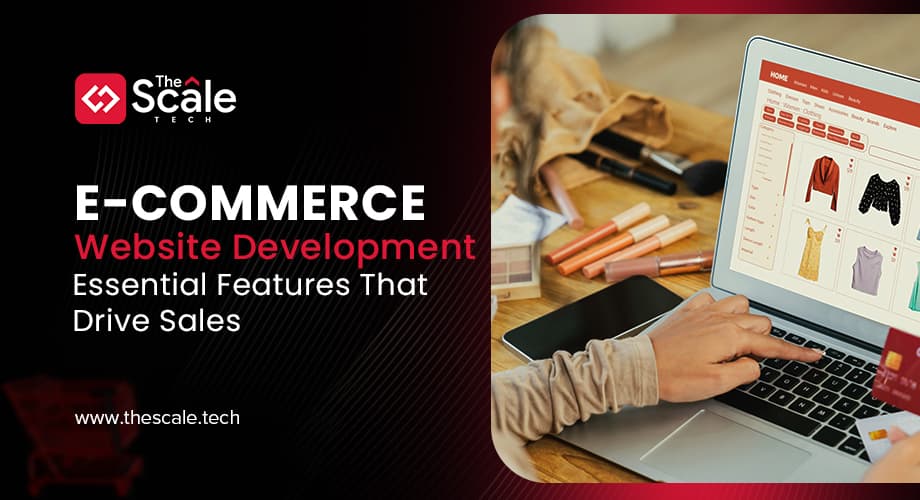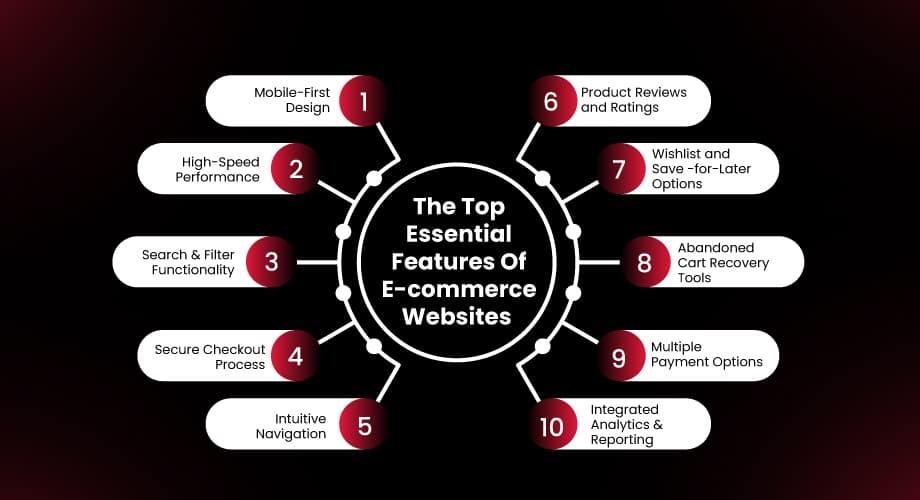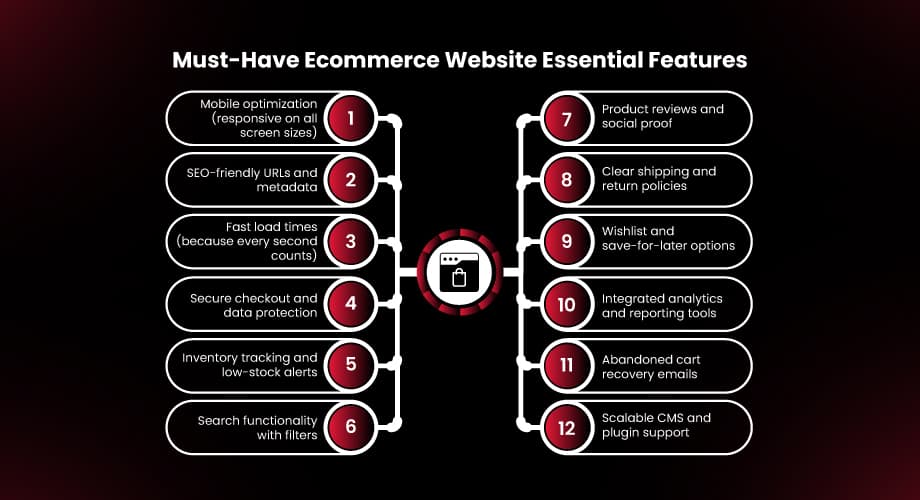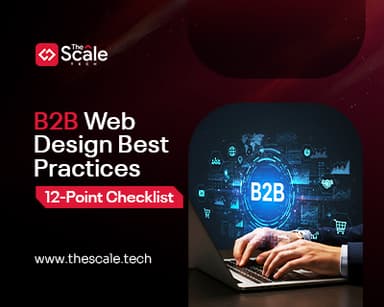
Game time! Guess what’s fast, global, always open, digitally established, and often boosts the amount on your credit card? Our answer is Ecommerce Website Development. If done the right way! Building an online store today isn’t just about “having a website.” It’s about crafting an intuitive, conversion-hungry beast that shoppers love to use and Google loves to rank.
And while the internet is bursting with cookie-cutter solutions, if you’re serious about boosting sales, you need to know the ecommerce website essential features that make all the difference between “Add to Cart” and “Abandon Cart.”
So buckle up. We’re diving into the must-haves of killer ecommerce website development, no fluff, just facts!
What Is E-commerce Website Development? Let’s Demystify It
Effective ecommerce website development focuses on creating an experience. It combines user-friendly design, performance optimization, secure payment integration, responsive layouts, and intuitive navigation to ensure visitors not only stay on your site but actually buy something.
Think of it as the digital equivalent of setting up a well-designed retail store:
- You want attractive displays (your UI).
- Clear signage and organization (your UX).
- And a checkout line that doesn’t make people want to abandon their cart in a panic (your payment flow).
Done right, it makes your products easy to find, simple to understand, and even easier to purchase. Done poorly, and well... users bounce faster than you can say "page not found."
In today’s fast-paced digital marketplace, ecommerce website development is less about just having an online presence and more about delivering a seamless, secure, and scalable shopping experience on any device, anytime. It’s where great design meets smart tech, and sales start happening.
The Top Essential Features Of E-commerce Websites
Let's analyze the essential ecommerce website features that every serious online retailer requires to succeed. These aren't "nice-to-haves, "they're the building blocks of a high-functioning ecommerce experience that converts browsers into buyers.

1. Mobile-First Design
With over 65% of consumers shopping and purchasing from mobile devices, it's no longer a choice to have a website that seamlessly translates to smaller screens. Mobile-first design makes it so that your layout, imagery, and functionality scale smoothly, whether someone's shopping from a desktop, tablet, or smartphone.
If your ecommerce website is not responsive, users will bounce. And likely, they won't return.
2. High-Speed Performance
Page speed is not only convenient – it has a direct link with conversions. Science indicates that having a load delay of a second can negatively affect conversions as much as 7%.
Well-designed, rapidly loading pages will ensure user engagement and diminish cart abandonment. Compression of pictures, browser cache options, and making code less chunky ensure smooth operation for the site, regardless of the devices they use.
3. Search & Filter Functionality
Shoppers want to see exactly what they're searching for, and at a quick pace. Advanced filtering and search functionality allow customers to narrow down products by size, color, price, brand, and other characteristics.
The ease of browsing through a large product database without frustration makes the user experience better and more likely to lead to a sale. It's one of the least appreciated yet strongest ecommerce website features.
4. Secure Checkout Process
A smooth, secure checkout process builds trust and ensures shoppers complete their purchases. Features like SSL encryption, two-factor authentication, and PCI compliance are critical for protecting customer data.
Transparency around shipping costs and return policies also plays a big role here. No one likes unpleasant surprises at checkout.
5. Intuitive Navigation
Your site should be easy to explore. Clear menus, logical category structures, and visible call-to-action buttons make it easy for users to browse and buy. Features like breadcrumbs and predictive search further improve usability.
6. Product Reviews and Ratings
Social proof matters. Let your customers speak for your brand through honest product reviews and star ratings. It builds trust, answers questions organically, and drives purchasing decisions with authenticity.
7. Wishlist and Save-for-Later Options
Not every visitor is ready to buy immediately. Allow users to save products for later. This simple feature not only improves user experience but also increases return visits and long-term engagement.
8. Abandoned Cart Recovery Tools
Sometimes customers need a nudge. Automated email reminders or push notifications that prompt users to complete their purchase are incredibly effective. Bonus: include a small discount or limited-time message for urgency.
9. Multiple Payment Options
From credit cards to digital wallets like PayPal, Apple Pay, or even Buy Now Pay Later (BNPL) services, offering flexible payment options ensures no one bounces due to limited choices at checkout.
10. Integrated Analytics & Reporting
Data is the backbone of ecommerce growth. Real-time dashboards that track traffic, behavior, conversion rates, and stock levels help store owners make informed decisions and optimize performance.
Great navigation helps users move from the homepage to the product page to checkout without getting lost—a key component of effective ecommerce website development.
Why Features Matter For An E-commerce Site
User expectations are higher than ever when it comes to online shopping. They desire fast-loading websites that are simple to navigate and easy to buy from. That's where the features of ecommerce websites become vital, and why they're so absolutely essential.
A site might look stunning, but if it doesn't have basic functionality, people won't linger. From competent search filtering and streamlined checkout to responsive design and payment security, the appropriate ecommerce website features directly relate to user satisfaction and conversion rates.
Consider these qualities to be the framework that keeps your store together. Without them, even the most attractive site can fail. Consumers who shop online are fast to leave if anything doesn't function. Spending on efficient, user-driven functionality is a necessity for remaining competitive in today's electronic marketplace.
Homepage & Product Pages: Where First Impressions Happen
Your homepage isn’t just a welcome mat; it’s your storefront window, your brand billboard, and your pitch deck all rolled into one. In the world of ecommerce website development, it’s often the first and only shot you get to capture attention.
What makes a homepage work?
- Visually Stunning: Clean, modern design is non-negotiable. You want to pull visitors in, not push them away with cluttered layouts and outdated graphics.
- Lightning Fast: Site speed affects everything! SEO, bounce rate, and, most importantly, conversions.
- Keyword-Optimized: The homepage is your SEO battleground. Make sure your core keyword appears naturally and strategically.
And then come the product pages, where the real decision-making happens. These are your silent salespeople.
Every product page should feature:
- High-Quality Images: Multiple angles, zoom functionality, lifestyle shots—this isn’t just about aesthetics. It helps customers feel confident in what they’re buying.
- Clear CTAs (Calls to Action): “Add to Cart” should be obvious, not a scavenger hunt.
- Persuasive Descriptions: Think benefits, not just features. Help people imagine owning the product.
Together, your homepage and product pages create a seamless flow. They're the dynamic duo of ecommerce website development, working in tandem to welcome, inform, and convert.
The “Invisible” Features That Matter
A beautiful front-end won’t get you far without a solid engine under the hood. This is where the skills of a top-tier ecommerce development company come into play.
These backend features might not be flashy, but they keep the business running like clockwork:
- Inventory Sync: Real-time updates mean no more selling out-of-stock items—or worse, disappointing customers.
- CRM Integration: Customer relationship management tools help you personalize communication and build loyalty.
- Order Management Automation: Streamlines everything from purchase to fulfillment, reducing manual errors.
- Shipping Calculator APIs: Accurate shipping costs help avoid cart abandonment.
- Real-Time Analytics Dashboards: Track user behavior, conversion rates, and inventory movement—all from one place.
In short, these “invisible” features make scaling possible. Without them, even the prettiest ecommerce site can collapse under pressure.
Features Of E-commerce That Drive Trust And Loyalty
Because One-Time Buyers Are So Last Year
Online shoppers don’t get to touch or try products before buying. That’s why trust is everything. And the features of ecommerce sites that build that trust can make a huge difference.
Here are a few essentials:
- User Reviews & Ratings: Shoppers trust other shoppers. Honest feedback builds confidence and drives conversions.
- Visible Return & Refund Policies: Don’t hide these in the footer. Clear, accessible policies reduce buyer hesitation.
- Real-Time Customer Support: Whether it’s a chatbot answering FAQs or a live agent resolving issues, responsiveness earns respect.
- Transparent Shipping Info: Clear timelines, costs, and tracking links can be the difference between a sale and a sigh.
These are not just ecommerce website features; they’re tools for earning long-term loyalty. When customers feel safe and informed, they’re more likely to come back.
The Pros Of Scalability
Planning For Your Future E-commerce Expansion
Your ecommerce business may start small, but it shouldn’t stay that way. Scalable design is a cornerstone of smart ecommerce website development.
What does scalability look like?
- Modular Architecture: Allows for easy upgrades without rebuilding the whole site.
- Plugin Flexibility: As your needs grow, you’ll want to add tools like loyalty programs, upselling features, or multi-language support.
- Global Readiness: Expanding into new markets? Make sure your platform supports different currencies, tax settings, and shipping zones.
With the right infrastructure, your site won’t just survive growth, it’ll thrive on it.
How An Ecommerce Development Company Gets It Right
Hiring a great ecommerce development company isn’t just about finding someone who can “build a website.” It’s about strategic thinking, technical expertise, and deep customer insight.
Here’s what separates the pros from the amateurs:
- User Experience Focus: Every design choice should make life easier for your visitors.
- Speed Optimization: Page load time can make or break conversions! Smart developers prioritize it.
- Data-Driven Decisions: A/B testing, heatmaps, and analytics aren’t extras; they’re essentials.
- SEO Best Practices: From metadata to site structure, everything should support visibility.
- Security Measures: SSL, secure payment gateways, and compliance protocols are baked in, not bolted on.
And most importantly? A good team asks the right questions, not just about how your site should look, but who it's for and how it should evolve.
Ecommerce Website Development Trends To Watch
Stay Ahead Or Get Left Behind
The digital marketplace moves fast, and the best ecommerce website development strategies keep pace with emerging trends.
Here’s what’s shaping the future:
- Voice Search Optimization: “Alexa, find me a new pair of shoes” isn’t science fiction—it’s sales in 2025.
- AI-Driven Product Suggestions: Tailored recommendations boost average order value and customer satisfaction.
- Headless Commerce: Decoupling frontend and backend gives you more design flexibility and faster performance.
- Augmented Reality (AR): Virtual try-ons and product previews are making online shopping feel a lot more personal.
Keeping an eye on these innovations ensures your store remains competitive and relevant.
Quick Checklist: Must-Have Ecommerce Website Essential Features
Let’s wrap this section up with a power-packed list. These ecommerce website essential features are foundational:

- Mobile optimization (responsive on all screen sizes)
- SEO-friendly URLs and metadata
- Fast load times (because every second counts)
- Secure checkout and data protection
- Inventory tracking and low-stock alerts
- Search functionality with filters
- Product reviews and social proof
- Clear shipping and return policies
- Wishlist and save-for-later options
- Integrated analytics and reporting tools
- Abandoned cart recovery emails
- Scalable CMS and plugin support
This is the blueprint of smart ecommerce website development —it ensures your site doesn’t just function, but performs.
Don’t Just Build A Store, Build An Experience!
Shoppers can choose from many different places to buy online. If your online store is not easy for people to use, very quick to load, and something they can trust, you are not just losing potential sales; you are letting those sales go to your competitors. To do well, you need to have all the essential ecommerce website features.
This means working with a smart ecommerce development company. Your site should be built to handle more business as you grow and should have a clear plan for success. By doing these things, you can create more opportunities for true growth and success in your online business. Because a store is simply a location. But a seamless, smart, secure customer experience? That drives conversions and makes them return.







